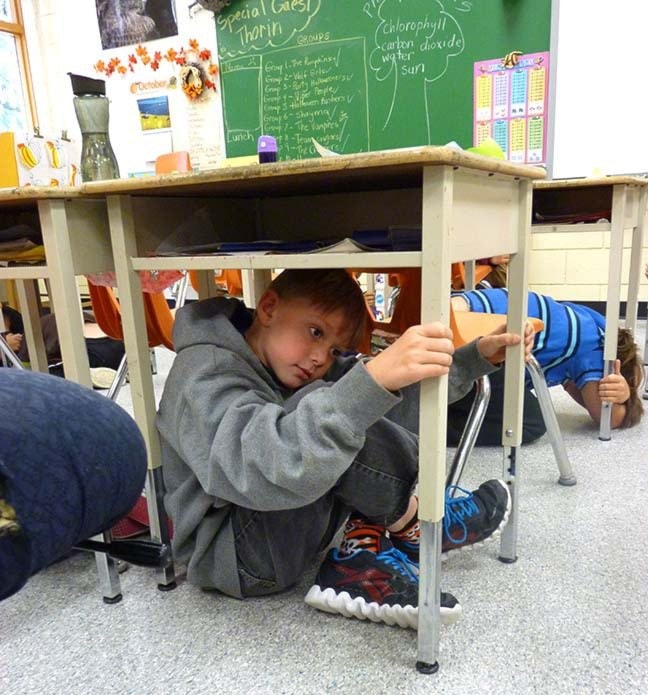Schools and businesses in Cranbrook took part in a province-wide earthquake drill on Thursday, October 17 at 11:17 a.m.
The Great British Columbia ShakeOut saw almost 700,000 people across the province practice what to do if an earthquake hits.
Participants in the ShakeOut dropped to their hands and knees, covered their head and neck under a sturdy table or desk, and held on for 60 seconds to prepare for a real earthquake.
The Pacific Coast of B.C. is the most earthquake prone region in Canada, hit by about 1,000 earthquakes a year. In the last 70 years, the offshore region to the west of Vancouver Island has had more than 100 earthquakes of magnitude five or greater.
Over in the East Kootenay, the risk is not as great, but our region can still experience strong earthquakes, according to Alison Bird, an earthquake seismologist with Earthquakes Canada.
"This is a region that can see damaging earthquakes. You have moderate to low hazard – you are much safer compared to those of us who are living on the west coast of B.C. – but there is still a chance of magnitude 5, even possibly magnitude 6, although that would be a very infrequent event," said Bird.
“You could see moderate to light damage to buildings, the kind of shaking that can knock things off shelves.”
East Kootenay residents should take precautions at home such as strapping book shelves to the studs, and storing heavy items low to the floor.
Families should have an emergency plan where they pre-arrange where to meet up after an emergency, identify safe exits from the home and neighbourhood, choose an out-of-area friend for everybody in the family to contact after the emergency, and put together an emergency kit.
“The kit really is an emergency kit, it’s not an earthquake kit. You have things like power outages and winter storms and all sorts of things you might need a kit for, so it really is a multi purpose situation,” said Bird.
A basic emergency kit should be easy to carry. It should contain enough water for each person to have two litres a day, food that won’t spoil such as canned food, energy bars and dried foods, special needs items such as medications, cash and change, and a copy of the emergency plan.
“It’s still important for people in your region to participate in things like the earthquake Shakeout drill, because even if you don’t experience an earthquake in the Kootenays, probably a lot of residents might travel, and a lot of places people might travel to are seismically active.”
The East Kootenay has experienced many small earthquakes in the past 30 years of less than 5 magnitude (see graphic at right). The closest major earthquake hit north of Revelstoke in 1918, with a magnitude of 6.
Bird said that in the East Kootenay, we would feel the “mega thrust” earthquake feared to hit the west coast of North America.
“Because of your distance, what you would end up feeling is sort of a long period of movement, rather than the jittery, sharp period of movement. It would be more of a long undulation, almost like being at sea. In fact, a lot of people who are at that distance from earthquakes describe being motion sick,” said Bird. “It’s a very different feeling than if you are close to the earthquake. It’s not like you just downgraded the amount of movement, it’s actually quite a different sensation.”
For more information on earthquake preparedness, visit www.shakeoutbc.ca.
